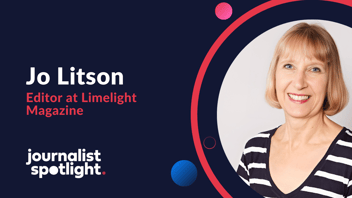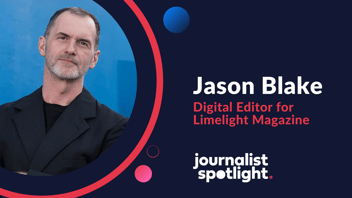Journalist Spotlight | Interview with Jane Albert, a Freelance Arts Writer and Deputy Editor
Today, Medianet is joined by Jane Albert, a Freelance Arts Writer and Deputy Editor whose work has been published by Broadsheet (Sydney), Harper’s Bazaar, Limelight and The Weekend Australian. 
Hi Jane! Can you tell me a bit about how you began a career as an Arts Writer and Editor?
I actually began in radio working as a producer at 2UE but quickly realised I didn’t have the right voice and so switched to News Ltd where I began as a copy person and worked my way up as a cadet and graded journalist. I worked across all publications (Sunday and Daily Telegraph and The Australian) and all rounds including daily news, the foreign desk and a stint in the Newcastle bureau. The arts are an area I’ve been passionate about since I was young so when I got the offer to join the arts team on The Australian, I jumped at it and have never looked back. I was soon appointed deputy arts editor so juggled the writing and editing, which I find really hones your skill as a journalist.
Since then I’ve regularly had the opportunity to assist editing various publications, including The List 100 | Arts + Culture for The Australian newspaper, an 88-page magazine in which we nominated and profiled the 100 most exciting people working in the arts at that time [2022]. It was nominated for Mumbrella Specialist Publication of the Year which was gratifying. My role involved supporting editor Tim Douglas [Tim edits Review in the Weekend Aus FYI] in editing, commissioning features and photography, writing and story suggestions.
As a freelance writer publishing for various publications, how do they differ in planning and producing content?
You always have to bear your readership in mind. I enjoy writing for Broadsheet (Sydney) as it’s a younger, culturally-savvy readership interested in what’s new and different.
A specialist art magazine on the other hand, like Limelight or the Review section in the Weekend Australian, has an audience with a different depth of knowledge. Features for those publications are longer and more in-depth so your research needs to be deeper to bring the knowledge to your writing. I factor in more time for both the interview and the writing for these pieces.
How is Arts Writing distinct from Arts Journalism? Alternatively, what advice do you have for those wanting to build a career in freelance writing?
I don’t think it is, to be honest. I think the two are interchangeable these days.
In terms of building a career in freelancing writing, I think the more you can see and the more conversations you can have, the better. Not only do you stay on top of who’s doing what, it also gives you a feel for the zeitgeist–what it is our artists are burning to talk about, what issues they’re addressing through their plays or dance or visual art or music or film.
You have to have a point of difference as a freelancer, you have to be able to pitch stories to editors they won’t already have received via a press release and could simply get a staff writer to do. So the more unique your story ideas are, the better!
I also pride myself on always meeting my deadlines, checking and double checking facts, names, titles of artworks, etc. Given the speed with which news and features are uploaded now, errors can creep in, and sub-editor resources are dwindling. If you can provide accurate copy from the beginning, you have done a lot of the heavy lifting.
How far in advance do you plan your content? And what’s your process in placing different stories to different publications?
It depends on the publication. Magazines like Wish, Harper’s Bazaar and Vogue have long lead times so you’re working a few months out, while the weekend papers and magazines have a much shorter turnaround.
As a freelancer writing for a mix of publications, you have to be comfortable keeping a lot of balls in the air and simply working to deadlines. It’s a juggle but it keeps life interesting!
I’m probably commissioned more than I pitch. But if you are pitching a story to a publication, you have to know who the readership is, what sorts of stories appeal to them, and of course what content has already been published. There’s nothing worse than pitching something to an editor only to be told they’ve already covered it. It’s embarrassing and unprofessional, although keeping across the never-ending content out there is also near-impossible!
You cover different facets of the arts sector, from music to the visual arts. What stories and perspectives are you most interested in writing about?
The reason I’ve stayed writing freelance as long as I have is that every single day is different. I’m motivated by learning, then sharing what I learn with readers. I get so much enjoyment and stimulation from the fact that every story opens my mind to something new.
I find artists are typically hoping to make the world a better place by exposing readers, viewers and audiences to different lives, thoughts and ideas from their own. They do that through all artforms. So the short answer is I don’t have a preference and enjoy the variety. I enjoy the cerebral–a new dance work from a contemporary choreographer such as the Australian Ballet’s recent production of Carmen that used everything from music to costume to choreography to explore gender stereotypes, sexuality and mental health in such a clever way. But I also always put up my hand each year to cover the Archibald, Wynne and Sulman prizes at the Art Gallery of NSW. That exhibition brings in viewers from all walks of life and is very approachable, which art should be. It’s also the one day of the year art is pretty much guaranteed to make the (proverbial) front page, always a win!
There seems to be a strong social consciousness in your freelance writing and your work for Alberts. Why is this important to you and have you received pushback regarding this before?
I think the arts by their nature tend to create a more empathetic society. In a film, book or play, we get to walk in someone else’s shoes for a night and see the world through different eyes. I’ve always been attracted to stories that have a strong social conscience, but then that mostly goes hand in hand with anything you’re writing about in the arts.
I used to receive pushback on this–stories I’d pitch that would be unkindly referred to as ‘dull but worthy’. Thankfully, this is increasingly rare today. Arts and magazine features editors are typically like-minded and believe in the power of storytelling to change lives and minds. It can be hard, given that readership is visible now (we have tools to work out how long someone’s eye stays on the page) and I know certain publications are driven by clickbait, but I think an editor’s responsibility is to give readers a range of articles and subjects, some that push them and others that just entertain.
Our family business, Alberts (now in its fifth generation), has always been driven by a desire to create a more vibrant, equitable world—whether that’s through our historical investment in music and film or the business’s focus today on investing in entrepreneurs who are pioneering a better future in mental health, the arts, the environment and equality. It’s a really exciting and satisfying space to work in.
Lastly, what do you look for in content pitching?
This is a great question as I think it’s pretty simple but a lot of publicists get it wrong! Know what round the journalist covers, know the publications they work with and perhaps most importantly, highlight the angle or story.
I get so many beautifully worded press releases and emails, but they’re about a new bespoke range of beer or line of skincare, subjects I never write about. You want a concise and preferably personalised pitch that gets straight to the point and is relevant. There are a handful of arts publicists I work with who are brilliant. I trust their judgement and know if they’re pitching an idea to me that it’s worth listening to. That is priceless.




